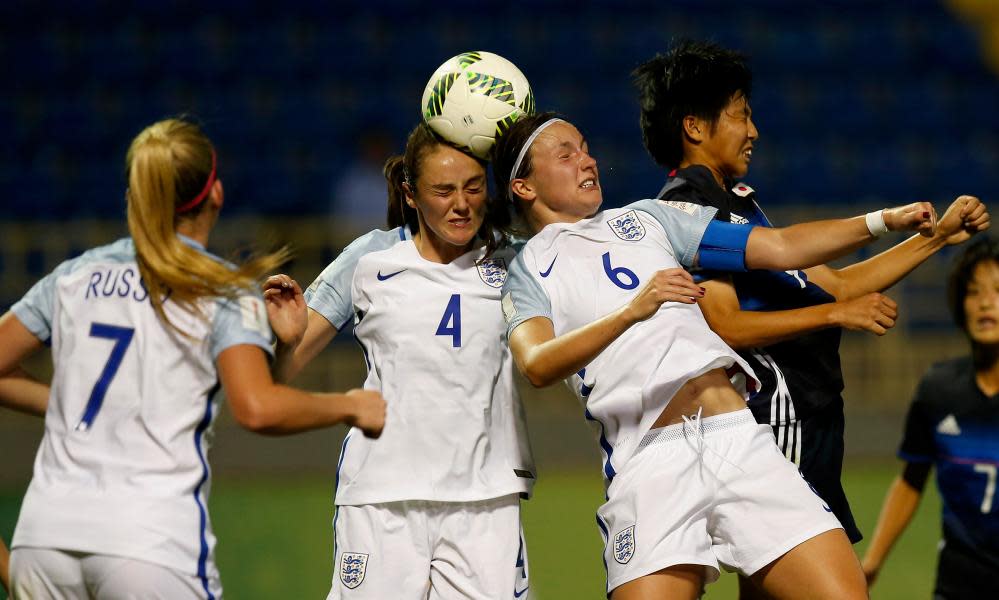Danger of heading footballs remains: women and children may be most at risk | Sean Ingle

It has become a depressingly familiar pattern. Dead sportsmen’s brains are sliced up, skewered under a microscope and the evidence of how their professions have wrecked their minds becomes horribly clear. Where American football leads, association football has followed. Last week research from Swansea University and University College London linked chronic, repetitive head impacts with chronic traumatic encephalopathy (CTE) and dementia in deceased players. Yet the broad direction of travel has long been established even before Jeff Astle’s early death in 2002 was ascribed by a coroner to “industrial disease” from heading heavy footballs.
No one disputes that this research is necessary and overdue. But the danger of always gazing backwards is that we miss what is in front of us. Fresh research suggests the dangers of heading didn’t disappear with the arrival of lighter and water-resistant balls, and the risks, particularly to children and teenage girls, may be under-appreciated.
In 2015 I wrote about ground-breaking research from scientists at Purdue University in Indiana which showed that even with modern footballs the forces involved in heading back goal-kicks and long punts were far higher than expected. Some registered at between 50Gs and 100Gs – similar to American football players smashing into each other or punches thrown by boxers.
The team at Purdue have now discovered another potentially worrying issue: that when teenage girls head a football regularly there is a risk of low‑level brain injuries, which in some cases lasts for four or five months before the brain looks normal on MRI scans. Think about that and ask yourself why, with all the money sloshing around football and flowing into agents’ pockets, aren’t more studies conducted?
The Purdue blueprint would be a good place to start. Their scientists recruited 26 female high school athletes – 14 of whom played soccer and 12 who did other non-collision sports such as track and field, swimming and basketball – and gave them several MRI scans over the course of a year. The soccer players were scanned before the season started, twice during the season and then two or three times after the season had ended. Each training session and match was also filmed, with players wearing an xPatch sensor behind their right ears, allowing the academics to record the impact of every header and collision greater than 20Gs of force .
The results were startling. While the soccer players didn’t suffer concussions, some of them developed what researchers called “marked cerebrovascular reactivity changes in the frontotemporal aspects of the brain”, which persisted for several months. “It is a big deal,” Eric Nauman, the director of the human injury research and regenerative technologies laboratory at Purdue, told me. “Some players saw pretty dramatic changes in their cerebral blood flow because of accumulating head impacts. Those levels changed significantly and stayed elevated. That was kind of a shock to us. We knew we would see those changes when we studied American football players but we didn’t in soccer.”
Nauman’s colleague Tom Talavage says they have as-yet unpublished data that strongly suggest a long-term physiological response to asymptomatic injury taking place – a form of inflammation coupled with elevated blood flow levels – which can be associated with tiredness, lower concentration levels and impaired cognitive function. “This response is arguably a ‘healing’ process but one has to consider the idea that if an adolescent’s brain is expending energy repairing itself, it is unlikely that its development is progressing optimally,” he adds.
In women’s sports it has long been known soccer has the largest number of traumatic brain injuries annually and has among the highest concussion rates, with rates slightly exceeding men’s football at the collegiate level. But this research shows sub-concussive injuries, from heading footballs, are also a potential issue.
What exacerbates the problem is that players usually don’t realise their brains have minor damage and so keep on playing, increasing the likelihood of more serious problems. “You can bruise any other part of your body and it feels sore so you lay off that spot,” says Nauman. “But your brain doesn’t have that kind of response.”
So what should be done? On Friday Uefa promised to undertake a research project which would count the number of times children aged eight to 12, and 14 to 16, head the ball in games and training sessions. But the Purdue scientists consider that insufficient. As they point out, every time kids dive or collide with each other there is a risk of whiplash or other rapid head movement that may well contribute to low-level damage that leads to injury.
Instead they suggest a number of measures: banning players under 12 from heading the ball – something that already happens in the US – and reducing the severity of such impacts among teenagers by making sure they are not playing and practising headers every day. “People argue that if youngsters can’t head the ball then they don’t learn proper technique but the big point is when you are 12 and under, your neck and shoulders and back aren’t strong enough for you to have proper technique,” says Nauman. But he wants to preserve the game not radically alter it. “It isn’t hard to reduce the head impacts in practice and save them for games. Really it is about giving the brain a chance to rest and recover.”

 Yahoo News
Yahoo News 
